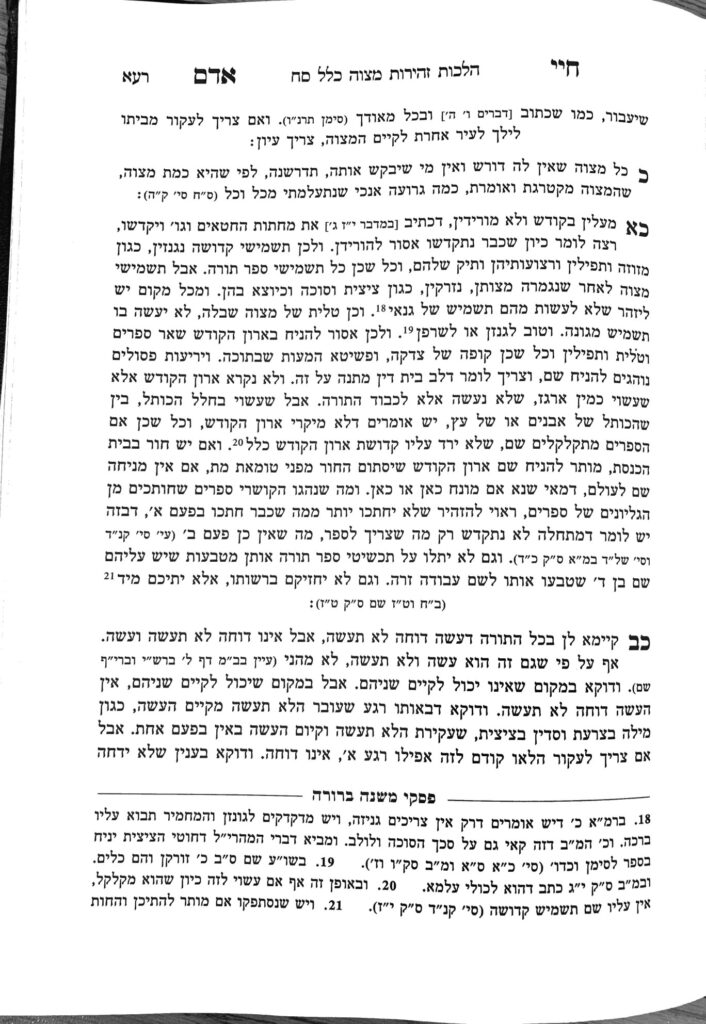We are continuing in siman 21, discussing the halachos of geniza. A question is discussed regarding a person who writes divrei Torah on a blackboard or whiteboard and wishes to erase it for the purpose of writing other divrei Torah, or for the purpose of a secular subject. Rav Yitzchok Elchonon Spektor ztl writes in a teshuva that when something was written with the intent to erase it, it is as though it was written with a tenai that it should not receive any kedusha, so it is muttar to erase. A person should still refrain from writing a name of Hashem under those circumstances, and there are poskim who hold that if it is written, that part of the board must be cut out and placed in geniza, as has happened in schools. This is the accepted psak.
Some suggest that this teshuva should be applied to newspapers, in that once it has become the nature of these items to be thrown out, it was as though they were written with a tenai that they should never receive kedusha, so it is muttar to throw them out. This suggestion is a limud zechus for those who are not careful, but it is very debatable whether one should rely on this argument at all. Newspapers are different from the blackboard, where the blackboard is clearly written on with intent to erase, as there is no other way to use the blackboard. Newspapers are printed, so it is possible to discard it appropriately. Even when this sevara can be applied, so the newspaper does not require geniza, it should not be discarded in a manner of bizayon, but should be wrapped before being thrown out.
Regarding sheets and homework brought home from school, the entire purpose of these sheets is for limmud hatorah, so the argument that it is not written for the purpose of kedusha cannot be applied. Although one may argue that they were written with a tenai, it is not a reliable sevara, and one should be careful with these sheets. The Chazon Ish was against giving such sheets to children, because it increases shaimos and a responsibility which the parents may not take care of properly.
Regarding newspapers which have divrei Torah, one may make the argument that they were written with a tenai, but it is not a reliable heter, as we learned above. Therefore, they should be placed in shaimos. If one is unsure whether there are divrei torah inside, one is not chayav to search inside for divrei Torah. The fact that the newspaper is written in Hebrew does not necessarily mean there are divrei Torah, so it does not increase the requirement to search through the newspaper.
If one does find divrei Torah, one may have thought that the entire newspaper should be placed in shaimos. On the other hand, some poskim write that it is a bizayon for the secular subjects of a newspaper to be placed with other divrei kedusha. Therefore, one should go through the newspaper and only place the divrei Torah in shaimos. Some poskim are meikil and write that one can even consider the other pages as a cover to the divrei Torah. Both opinions are brought down and there is no clear psak.
There is an opinion that in America, where those handling the garbage are not Jewish, if one places geniza next to the garbage, they are only destroying it through a grama. We allowed grama when there is a tzorech mitzvah. Due to the tremendous amounts of shaimos, there is an element of a tzorech. Therefore, there are some who suggest that to double wrap and place the newspaper next to the garbage is a grama and is muttar.
There is a fourth opinion that one may double wrap the newspaper and place it directly into the garbage, based on the sevara of tenai mentioned before.
There is no clear psak on this question. In sefer Ginzei Hakodesh, he brings down all four opinions without a clear psak. However, it is clear that a weekly insert which is independent from the rest of the newspaper would require geniza according to all opinions.
Summary
- As part of the issur to cause bizayon to shaimos, it is assur to write a name of Hashem, a pasuk, or any other divrei Torah which require geniza, if there is concern it will not be taken care of properly.
- If it was written with the intent to erase it, it is as though it was written with a tenai that it should not receive any kedusha, so it is muttar to erase.
- This sevara is not applied to the name of Hashem, and if it were written, it would still require geniza.
- Some wish to apply this sevara to newspapers and homework sheets, but it is not reliable.
- One is not chayav to search through a newspaper to check for divrei Torah if they are unsure whether there any any
There are four opinions regarding the proper disposal of a newspaper with shaimos:
- Shaimos for the entire newspaper;
- Shamos for the divrei Torah only;
- Throw out through grama;
- Throw out directly.



